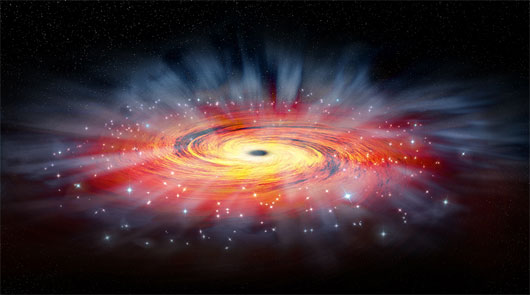The galaxy's giant black hole
Astronomers at NASA's Chandra X-ray Observatory have taken an important step in explaining why matter around the giant black hole in the center of the Milky Way is extremely faint under X-rays. This discovery is very important for our understanding of black holes.
>>>New conjecture about the shape of a black hole
Chandra's new image of Sagittarius A * (Sgr A *) , located about 26,000 light-years from Earth, indicates that only less than one percent of the initial gas is within Sgr A's attractive range. to the point of no return, also known as the event horizon. Instead, most of the gas is ejected before it is near the event horizon and has a chance to light up, resulting in weak X-rays.
These new findings are the result of one of Chandra's longest observation campaigns ever made. The spacecraft collected data about Sgr A * within five weeks in 2012. The researchers used this observation time to capture very sensitive X-ray images and details of anomalies, and marks. The energy effect of superheated gas swirled around Sgr A *, weighing about 4 million times the Sun.

Photo: peterdedmonds.blogspot.com
"We think that most large galaxies have a supermassive black hole in their mind, but they're too far away for us to study how matter flows near it," said Q. Daniel Wang of Dai. University of Massachusetts at Amherst, head of a study published Thursday in Science magazine. "Sgr A * is one of the few black holes close enough for us to actually witness this process."
The researchers found that Chandra's data about Sgr A * does not support the theoretical model in which X-rays emanate from a small mass of stars around the black hole. Instead, the X-ray data showed that gas near the black hole could have originated from the wind generated by a disc-shaped distribution of older young stars.
"These new Chandra images are one of the best images I've ever seen," said co-author Sera Markoff of the University of Amsterdam. "We are watching Sgr A * catch hot air sprayed from the nearby star, and bring it to its event horizon."
To go through the event horizon, matter captured by a black hole must lose heat and momentum. The material release allows this to happen.
"Most of the gases must be thrown out so that a small amount can reach the black hole," said Shanghai Observatory co-author Feng Yuan. "Contrary to what some people think, black holes do not really devour everything pulled towards them. Sgr A * seems to find a lot of food that is difficult to swallow."
The gas available to Sgr A * is very diffuse and super hot, so it is difficult for black holes to capture and swallow it. Gluttonous black holes cause quasars and produce large amounts of radiation containing cooler and denser air than Sgr A *.
Sgr A * event horizon has a black shadow against light materials around the black hole. This study can support efforts to use radio telescopes to observe and understand the darkness. It will also be useful for understanding the impact of orbiting stars and gas clouds with matter flowing in and out of the black hole.
- Discovering 'super black holes' is 12 times bigger than the Sun.
- This is the surreal image of the black hole in the universe
- Evidence of the power of black holes
- Catching a super rare scene in the universe: Super giant black hole is swallowing up a star
- Science warns super giant black holes that can
- Monster black hole 'belching' twice after swallowing gas
- The first time a black hole was discovered, it swallowed a star
- What scary thing will happen if you touch a black hole?
- Is there a 'black hole solar system' that owns ... 10,000 planets?
- Detecting a black hole
- Detecting black holes 'monsters' 350 million times more massive than the Sun.
- Discover the mystery of the most exotic black holes in the universe
 Van Allen's belt and evidence that the Apollo 11 mission to the Moon was myth
Van Allen's belt and evidence that the Apollo 11 mission to the Moon was myth The levels of civilization in the universe (Kardashev scale)
The levels of civilization in the universe (Kardashev scale) Today Mars, the sun and the Earth are aligned
Today Mars, the sun and the Earth are aligned The Amazon owner announced a secret plan to build a space base for thousands of people
The Amazon owner announced a secret plan to build a space base for thousands of people